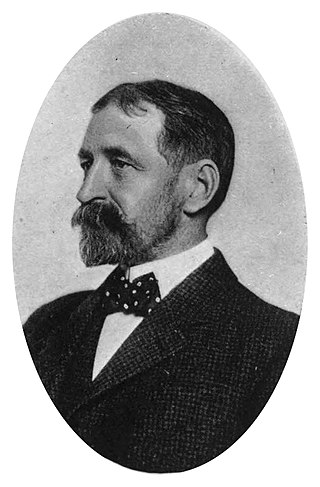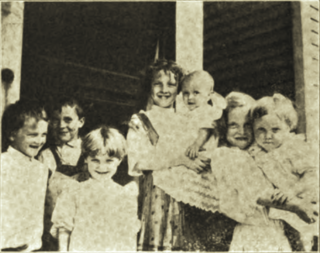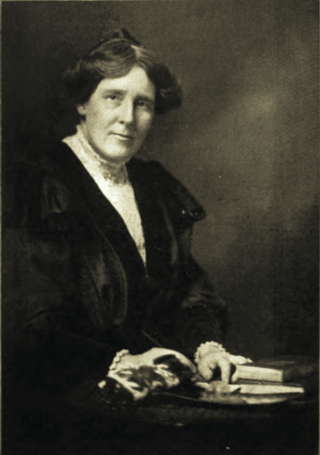
The Stanley-Whitman House is a historic house museum at 37 High Street in Farmington, Connecticut. Built ca 1720, it is one of the oldest houses in Farmington. A well-preserved saltbox with post-medieval construction features, it was designated a National Historic Landmark in 1960.

St. Mary is a Roman Catholic church in Norwalk, Connecticut, part of the Diocese of Bridgeport. As the first Catholic Church in Norwalk from which three other parishes developed, St. Mary's is considered the Mother Church of Norwalk.

Henry Walcott Farnam was an American economist.

Euphemia Wilson Pitblado was a Scottish-born American women's activist, social reformer, and writer. She traveled in Europe, Canada, and in the United States, crossing the Atlantic five times. Pitblado was a delegate to the National Woman Suffrage Association Convention in Washington, D.C., the New England Woman's Suffrage Association Conventions, the National Woman's Christian Temperance Union (WCTU) Conventions in New York City, Denver, and Chicago, and to the annual Woman's Foreign Missionary Conventions in Boston and Lowell, Massachusetts. Her principal literary works were addresses upon temperance, suffrage, missions, education, and religion.

Alice Ives Breed was an American social leader, salonnière, and clubwoman. She excelled as an organizer, using her executive abilities in religious, philanthropic, literary and social channels, aiming to improve the community.

Lilian Carpenter Streeter was an American social reformer, organizational founder, clubwoman, and author. She founded the Concord Woman's Club, and the New Hampshire Federation of Woman's Clubs. Having lived in Concord, New Hampshire from 1877 till her death, she was active in every social, educational, and philanthropic movement that was brought to her notice, and her actions commanded the support and cooperation of other women. At the National Conference of Charities and Corrections, held in Baltimore, Maryland, 1915, Streeter gave a paper entitled, "The Relation of Mental Defect to the Neglected, Dependent, and Delinquent Children of New Hampshire", making her the first woman to give a paper of this kind at a national conference. Streeter's articles on social and charitable topics appeared in magazines of the day.

Rivington Street Settlement was an American settlement house which provided educational and social services on the Lower East Side of the Manhattan borough of New York City, New York. Under the auspices of the College Settlements Association (CSA), it focused on the mostly immigrant population of the neighborhood. Originally located at 95 Rivington Street (1889-), other locations later included 96 Rivington Street (1892-1901), 188 Ludlow Street (1902–), 84-86 First Street (1907-), and Summer Home, Mount Ivy, New York (1900-). The Rivington Street Settlement was established by college women, was controlled by college women, and had a majority of college women as residents. The Rivington Street Settlement was a kind of graduate school in economics and sociology, with practical lessons in a tenement–house district - a kind of sociological laboratory.

College Settlement of Philadelphia is an American outdoor camp and school located in Horsham, Pennsylvania. Established in 1892, it was originally associated with the settlement movement under the auspices of the College Settlements Association (CSA) to provide educational and social services in South Philadelphia, Pennsylvania, focusing on the mostly immigrant population of the neighborhood it served, and providing a home to the children and young people of the neighborhood.

Orange Valley Social Institute was an American settlement house established during the settlement movement era to provide educational and social opportunities for the people of the neighborhood. It was located close to Newark in The Oranges' hatting district at No. 35 Tompkins street, Orange Valley, New Jersey. Opened April 1, 1897, under the auspices of a committee of citizens of Orange, New Jersey, it was later governed by a Board of Directors of the Settlement Association. It was maintained by private contributions. Head residents included Bryant Venable, The settlement contained a kindergarten, boys' games club, basket weaving club, shuffleboard club, mothers' meetings, chair caning club, bowling club and a library. In the first nine months of 1902, 497 persons borrowed 3,568 books, while there was an average daily attendance of about 30 at the reading rooms.

Goodrich Social Settlement was the second settlement house in Cleveland, Ohio, after Hiram House. It organized on December 9, 1896, incorporated May 15, 1897, and opened May 20, 1897 at Bond St. and St. Clair Ave. It was established by Flora Stone Mather as an outgrowth of a boys' club and women's guild conducted by the First Presbyterian Church. Its aims were “to provide a center for such activities as are commonly associated with Christian social settlement work". It was maintained by an endowment. The Goodrich House Farm, in Euclid Point, Ohio, was part of the settlement.

University of Chicago Settlement was a settlement of the University of Chicago. It was established January, 1894, by the Philanthropic Committee of the Christian Union of the University of Chicago. Initially, two graduate students were in residence "to provide a center for educational, religious and philanthropic work." Mary McDowell became head resident September 15, 1894.

Neighborhood House was an American settlement house in Chicago, Illinois. It was opened in October 1896, by Samuel S. and Harriet M. Van Der Vaart, under the auspices of the Young People's Society of the Universalist Church, of Englewood, Chicago, and with the assistance of teachers of the Perkins, Bass, and D. S. Wentworth public schools. It was officially established in the Fall of 1897 by Harriet Van Der Vaart as the outgrowth of the kindergarten opened the year before "to bring together for mutual benefit people of different classes and conditions."
Neighborhood House is an American community center located in Louisville, Kentucky. Founded in 1896, as North Broadway Social Settlement it was renamed Neighborhood House in 1902, when it incorporated.
Whittier House was an American social settlement, situated in the midst of the densely populated Paulus Hook district of Jersey City, New Jersey. Christian, but non-denominational, its aims were to help all in need by improving their circumstances, by inspiring them with new motives and higher ideals, and by making them better fitted by the responsibilities and privileges of life. It cooperated with all who were seeking to ameliorate the human condition and improve the social order. It opened in the People's Palace, December 20, 1893. On May 14, 1894, it incorporated and moved to 174 Grand Street.

Lawrence House was an American social settlement in Baltimore, Maryland. Its beginnings were in 1893, when Rev. Dr. Edward A. Lawrence and a friend took up lodging at 214 Parkin Street. Lawrence died suddenly later in 1893, and in his memory, the Lawrence Memorial Association organized in 1894 and purchased a house at 816 West Lombard Street. The settlement incorporated in the Fall of 1900. In 1904, the place was enlarged by the addition of the adjoining house, 814 West Lombard Street.

Civic Service House was an American social settlement and a school for citizenship, located at 110-112 Salem Street, Boston, Massachusetts. Established October, 1901, by Pauline Agassiz Shaw as a center for civic education, recreation, and organization for the common good. The house set out to do specialized settlement work along civic lines, and purposed to reach a constituency approaching or within the privileges of citizenship. The character of work was that with adult immigrants, in clubs, classes, lectures and civic committees. The constituency included Jews, Italians, Poles and Irish. Improvement clubs, educational classes for men and women, occasional concerts and recreational features were available, but these were subordinate to the effort for civic betterment. Children's work was not included, and social features were made incidental to a program of study and service.
Delia Lyman Porter was an American author, social reformer, and clubwoman. She was a prominent civic worker, associated with the prohibition and the parent–teacher association movements. Porter published books, calendars, short stories, compilations, articles, and religious outlines.

South Park Settlement was an American settlement movement-era settlement established in the South Park neighborhood of San Francisco, California on January 2, 1895, by the San Francisco Settlement Association. It was founded in one of the crowded districts of San Francisco. The pretty little oval park on which the Settlement House faces was formerly the fashionable residence district of the city. But within a few blocks on either side of South Park were many little streets, whose crowded tenements furnished homes for less prosperous working people. Its goals were to establish and maintain a settlement in San Francisco as a residence for persons interested in the social and moral condition of its neighborhood; to bring into friendly and helpful relations with one another the people of the neighborhood in which the settlement was situated; to cooperate with church, educational, charitable and labor organizations, and with other agencies acting for the improvement of social conditions; to serve as a medium among the different social elements of the city for bringing about a more intelligent and systematic understanding of their mutual obligations; as well as to do social and educational work in the neighborhood; co-operate in the civic work of the city; and investigate social and economic conditions.

Clara Bancroft Beatley was an American educator, lecturer, and author, as well as a clubwoman and suffragist. A a descendant of staunch Unitarians, for many years, she served as the principal of the Church of the Disciples school in Boston, Massachusetts.
Amity Church Settlement was an American settlement house founded in 1896 and auxiliary to Amity Baptist Church. It was located at 314 West 54th Street in the Manhattan borough of New York City, New York. Its purpose included the religious and social well-being of the neighborhood. Services included educational classes, lectures, and poor relief. The director was Rev. Leighton Williams, Pastor. The undenominational spirit and able management of the House attracted confidence and financial assistance from outside Baptist lines. Its basal function was that of establishing residence in the crowded neighborhood where its work lay and bringing to bear upon the labor in hand the influence of the home. It sought to unite the idea of the Church and of the social settlement. The settlement was unincorporated, and was maintained by Amity Baptist Church and by voluntary contributions. The work was classified as (1) religious, including the various church services; (2) educational, including kindergarten, industrial school, evening classes, public lectures under the board of education; (3) medical, including dispensary and nursing work; (4) social, including Workingmen's Institute, social clubs and entertainments; (5) relief work; and (6) neighborhood work, including visitation and all work outside of the building, as well as promotion of neighborhood interests.
















